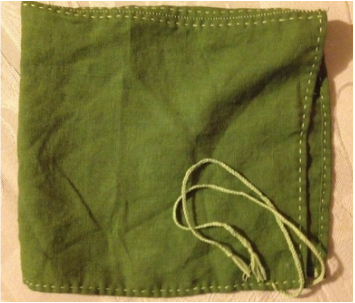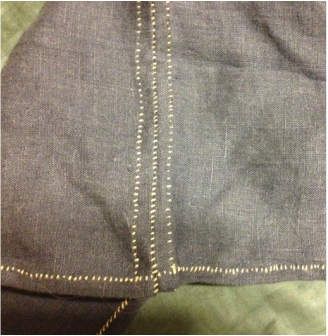So what have I learned recently?
- My favorite combination of seams is not present among extant Viking textiles that I have studied. For hand sewing I prefer (and have gotten good at) hemming the edges of each piece of my garment using a running stitch. I then join the pieces together with an over cast stitch. It works well, makes for a strong seam, and I can do it quickly. The problem with this is that while both overcast and running stitches are period, I cannot adequately souce where they were used together in the way that I use them. Could I still make a case for using this based on other combinations we do see in extant textiles? Absolutely, but for future items that I will be documenting, I will definitely be switching to use of overcast for both the rolled edges and the seam joining.
See those two Dublin caps above? I do not actually consider those seams embellished. All rows of stitching are necessary and functional. Even if I used a brilliantly colored contrasting thread, those seams still serve a purpose. (Of course, use of colored thread on seams was also a rarity, but that is a topic for another time.) Examples of true seam embellishment would be laying cord over the seam and stitching it down or doing a decorative row of stitching by using something like osenstitch to cover the seam joining. I personally love this type of decoration, but plan to use it a bit more judiciously in the future.
What brought me to this conclusion? Well, as mentioned earlier, I have been in the process of reevaluating things I learned early on in my journey. One of those things was that herringbone stitch is period for Vikings. At the time (when making my first dress) that was good enough for me! Looking deeper, I have discovered that the stitch so favored by reenactors was never found used as an embellishment on a garment (at least not that I can find).
What examples do we have of this stitch specifically from Viking era and place?
- Hedeby harbor has a textile fragment that is hemmed using a herringbone stitch. however, the herringbone is over the edge of the hem, and hence, likely that the part of the stitch we consider decorative was on the inside of the garment, with what would look like parallel rows of running stitch on the outside. (As described by Inga Hagg)
- The find 6-8 Pavement at York has a fragment of a hemmed garment that is worked in Herringbone. As with the Hedeby find, the herringbone is on the inside of the garment. (Cordage and Fiber from 16-22 Coppergate, by Penelope Walton Rogers)
- The Mammen cushion has a variant of very closely worked herringbone over a seam (you can see that here http://www.cs.vassar.edu/~capriest/vikembroid.html ). So here a decorative stitch is used over a seam of a household item, not a garment. (And it is important to note that this stitching was only 2.5mm wide. There is no open space in the stitching, making it resemble a tight, narrow braid. This is entirely unlike the herringbone typically worked by reenactors over seams.)
- The Skjoldehamn tunic has a stitch similar to that used at Mammen at the neckline. The issue with this one is that this find may or may not even be Viking and if it is, it seems to reflect a very different type of fashion than we find further south and that alone makes me leery of using it as a basis for embellishment on a Viking kit without further substantiating evidence. Beyond that, the tunic itself is dated post-Viking era. As with Mammen, this stitch is still much more narrow than reenactors use, and, again, it is more filled in. (http://www.ceilingpress.com/Resources/Nye%20tanker%20om%20Skjoldehamnfunnet.pdf )
- Additionally, there is a 10th century reliquary pouch from York that uses a what Penelope Walton Rogers calls "catch stitch". Typically catch stitch is another name for Herringbone, but in this case, the diagram in the materials shows a different type of blind catch stitch being executed. Stitches are predominantly on the inside of the item and this would not be a decorative stitch at all. This item is described in an article in NESAT III and Textiles, Cordage and Fiber from 16-22 Coppergate, both by Penelope Walton Rogers.
Four samples only (out of hundreds of textiles), and none of them has the stitch displayed in the manner we commonly see it at events (and two of the four are different than a normal herringbone, two are inside the item, and one might not be Viking...). This does not make a terribly good case in my eyes for extensive use of this decoration.
Now, will I remove all of my hard work from garments I have already made? I cannot say that is the case. I will, however, be more judicious in use of the stitch in future projects as I attempt to better recreate clothing of the past.
Over all, I think the key is, for anyone with an interest in recreation to not get so comfortable in what they "know" that they never take time to look back and reevaluate things (or accept new evidence as they find it). It can be a little frustrating, of course, especially when one has painstakingly applied a mile of herringbone stitching to a garment. But in reality, I find these discoveries exciting in a way. I lets me see how far I have come, and gives me a more clear path in my journey of recreating historic arts!


 RSS Feed
RSS Feed